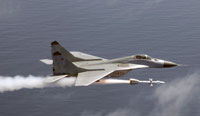The R-27
(NATO name: AA-10 Alamo) is the medium-range air-to-air missile (MRAAM)
developed by the Soviet Union/Russian Vympel Design Bureau in the
early 1980s.
The Peoples Liberation Army Air Force received the missile as a part of the weapon
package for the Su-27 fighters it purchased in the early 1990s.
Currently the PLAAF is equipped with at least three models: the
semi-active radar-homing variant R-27R (AA-10A Alamo-A), the IR-homing
variant R-27T (AA-10B Alamo-B), and the active radar-homing variant
R-27AE (AA-10 Alamo-E).
The R-27 (AA-10) MRAAM family was introduced in the 1980s for the
Soviet Unionís fourth-generation fighters such as the Su-27 and
Mig-29, with a total of six variants developed with different seekers
and engines.
The missile is also carried by improved versions of the
MiG-21, MiG-23 and MiG-25. The missile was developed as a counter to
the U.S. AIM-7F Sparrow MRAAM. China purchased unknown numbers of the
R-27 missiles in several batches during the 1990s to arm its Su-27
fleet.
The R-27
missiles are intended to intercept and defeat aircraft and helicopters
of all types, unmanned reconnaissance aircraft and cruise missiles
under active enemy electronic jamming, counteractions and manoeuvring.
There are produced some variants of the AA-10 "Alamo" with two
different seeker types - semi-active radar homing and infrared, and
two types of engines - with standard and extended range engine.
|
AA-10 Specifications |
|
Type |
Medium range
intercept missile |
|
Manufacturer |
Vympel |
|
Weight |
235kg |
|
Warhead |
39kg expanding rod |
|
Length |
4m |
|
Diameter |
230mm |
|
Performance |
Max speed Mach 4, range
0.2km to 80km, guidance semi-active radar homing |

